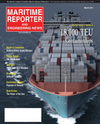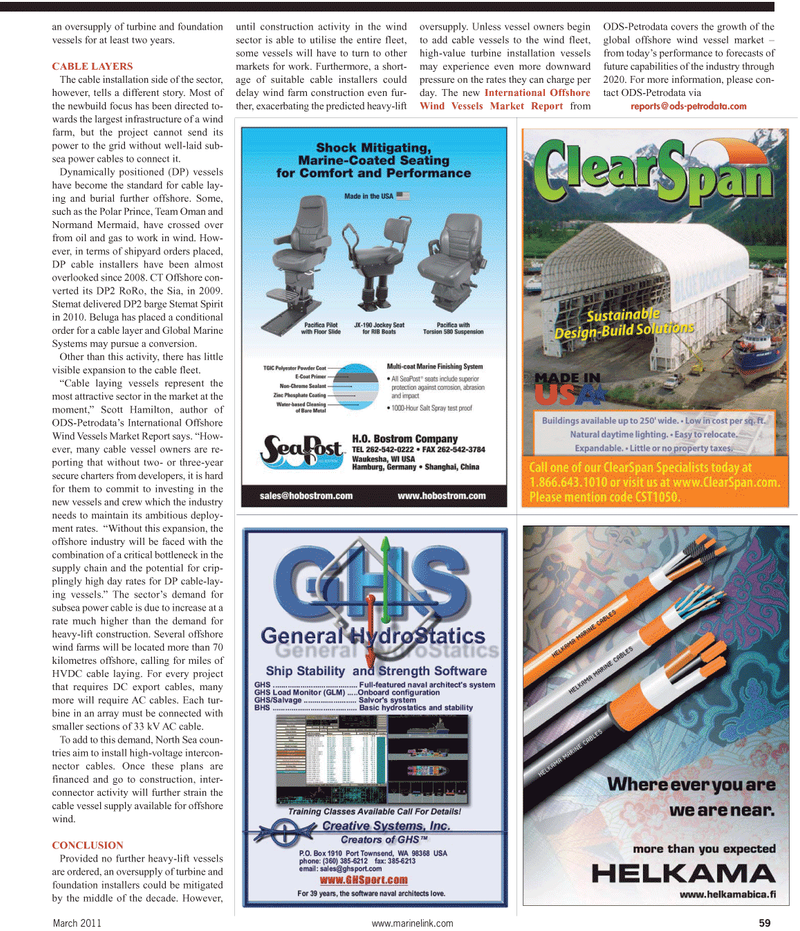
Page 59: of Maritime Reporter Magazine (March 2011)
Ship Repair & Conversion
Read this page in Pdf, Flash or Html5 edition of March 2011 Maritime Reporter Magazine
an oversupply of turbine and foundation vessels for at least two years.
CABLE LAYERS
The cable installation side of the sector, however, tells a different story. Most of the newbuild focus has been directed to- wards the largest infrastructure of a wind farm, but the project cannot send its power to the grid without well-laid sub- sea power cables to connect it.
Dynamically positioned (DP) vessels have become the standard for cable lay- ing and burial further offshore. Some, such as the Polar Prince, Team Oman and
Normand Mermaid, have crossed over from oil and gas to work in wind. How- ever, in terms of shipyard orders placed,
DP cable installers have been almost overlooked since 2008. CT Offshore con- verted its DP2 RoRo, the Sia, in 2009.
Stemat delivered DP2 barge Stemat Spirit in 2010. Beluga has placed a conditional order for a cable layer and Global Marine
Systems may pursue a conversion.
Other than this activity, there has little visible expansion to the cable fleet. “Cable laying vessels represent the most attractive sector in the market at the moment,” Scott Hamilton, author of
ODS-Petrodata’s International Offshore
Wind Vessels Market Report says. “How- ever, many cable vessel owners are re- porting that without two- or three-year secure charters from developers, it is hard for them to commit to investing in the new vessels and crew which the industry needs to maintain its ambitious deploy- ment rates. “Without this expansion, the offshore industry will be faced with the combination of a critical bottleneck in the supply chain and the potential for crip- plingly high day rates for DP cable-lay- ing vessels.” The sector’s demand for subsea power cable is due to increase at a rate much higher than the demand for heavy-lift construction. Several offshore wind farms will be located more than 70 kilometres offshore, calling for miles of
HVDC cable laying. For every project that requires DC export cables, many more will require AC cables. Each tur- bine in an array must be connected with smaller sections of 33 kV AC cable.
To add to this demand, North Sea coun- tries aim to install high-voltage intercon- nector cables. Once these plans are financed and go to construction, inter- connector activity will further strain the cable vessel supply available for offshore wind.
CONCLUSION
Provided no further heavy-lift vessels are ordered, an oversupply of turbine and foundation installers could be mitigated by the middle of the decade. However, until construction activity in the wind sector is able to utilise the entire fleet, some vessels will have to turn to other markets for work. Furthermore, a short- age of suitable cable installers could delay wind farm construction even fur- ther, exacerbating the predicted heavy-lift oversupply. Unless vessel owners begin to add cable vessels to the wind fleet, high-value turbine installation vessels may experience even more downward pressure on the rates they can charge per day. The new International Offshore
Wind Vessels Market Report from
ODS-Petrodata covers the growth of the global offshore wind vessel market – from today’s performance to forecasts of future capabilities of the industry through 2020. For more information, please con- tact ODS-Petrodata via [email protected]
March 2011 www.marinelink.com 59

 58
58

 60
60
